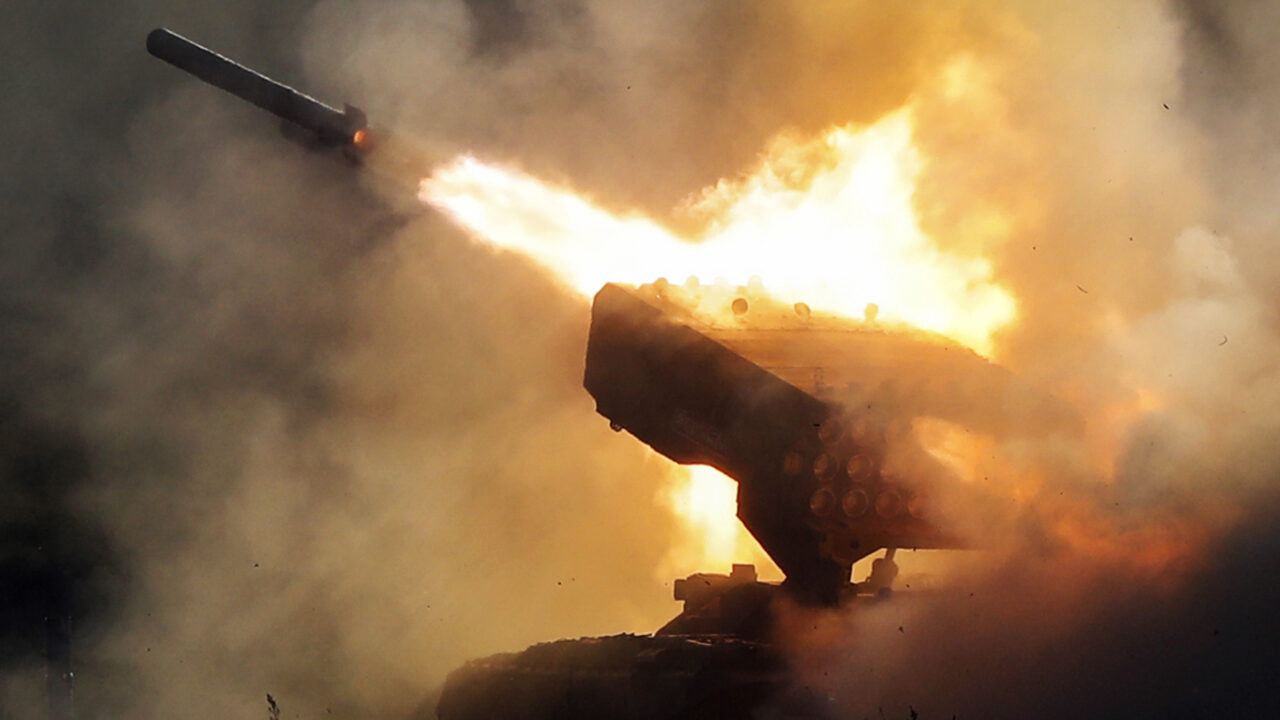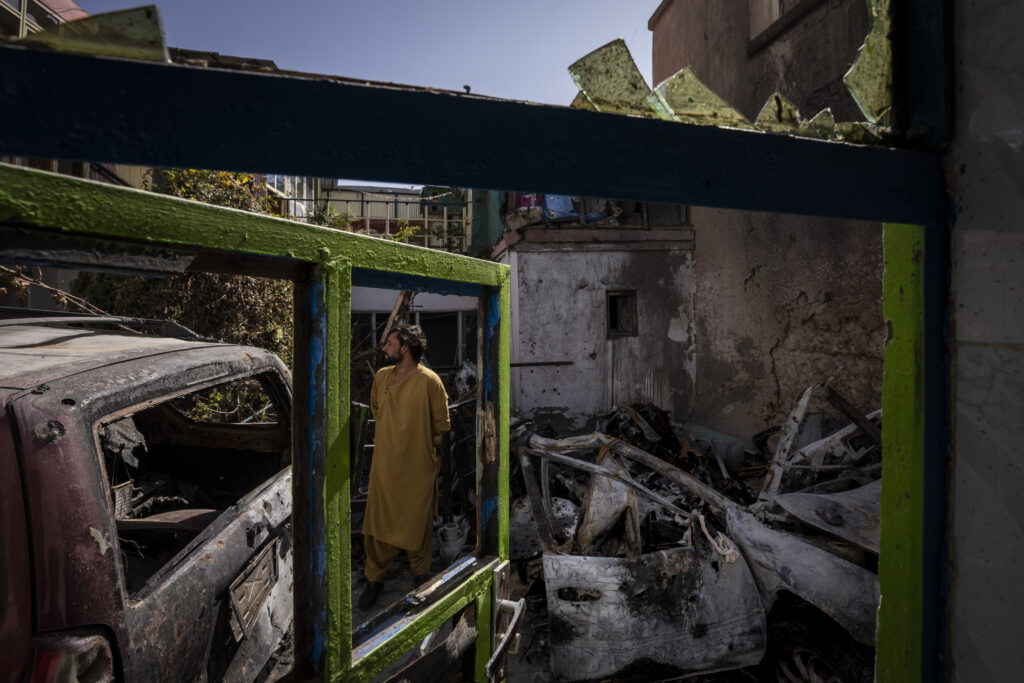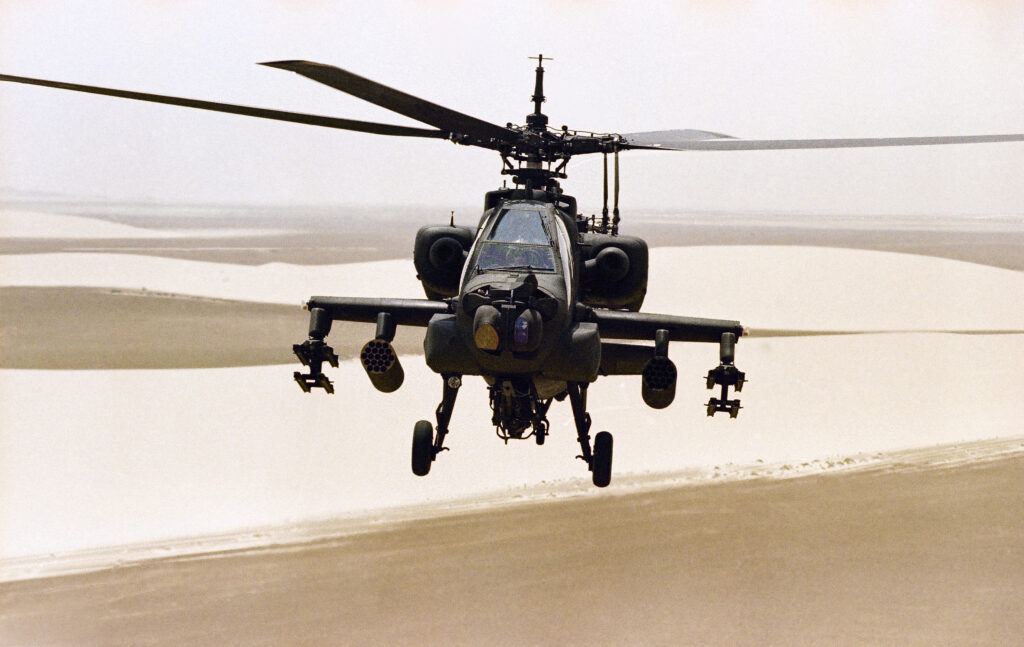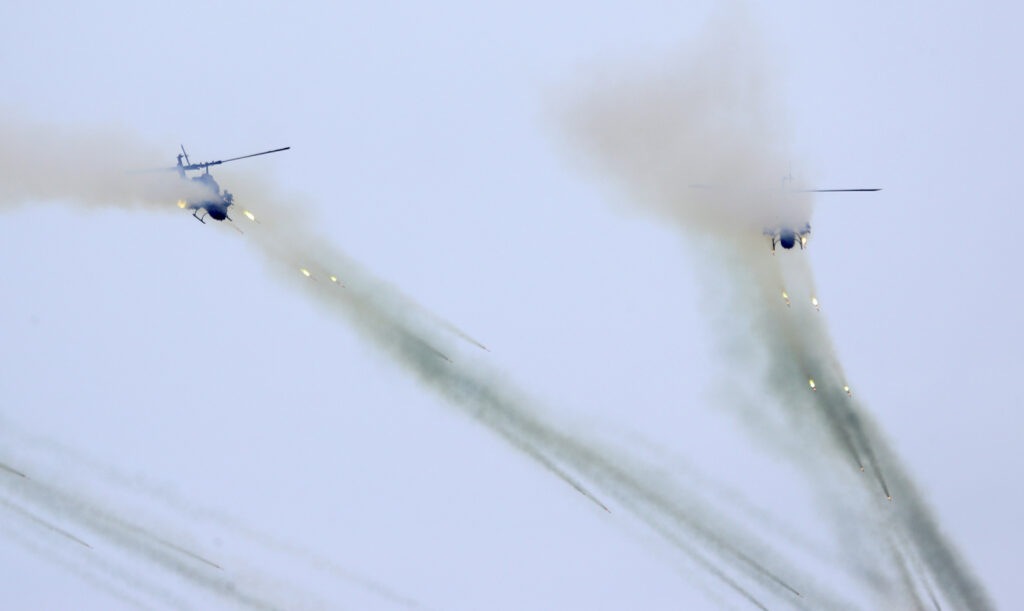The Gruesome Frontier of Thermobaric Weapons
As these “heat and pressure” explosive munitions become more widely used, observers say international law is “utterly inadequate.” Russian thermobaric system TOS-1 fires during the International Military Technical Forum Army-2018 in Alabino, outside Moscow, Tuesday, Aug. 21, 2018. (AP Photo/Pavel Golovkin)
Russian thermobaric system TOS-1 fires during the International Military Technical Forum Army-2018 in Alabino, outside Moscow, Tuesday, Aug. 21, 2018. (AP Photo/Pavel Golovkin)
Death from a thermobaric weapon is articulated by two events. The first is the release of the fuel aerosol. The second is the igniting of the aerosol.
Within the immediate vicinity of the explosion, flesh is pulverized, blown to bits or melted as the temperature reaches up to 3000°C, about half as hot as the sun. The burning fuel can be inhaled, incinerating a person from the inside out. Lungs, ears, sinuses and intestines are particularly vulnerable, collapsing as the vacuum created by the combustion sucks the oxygen from the surrounding air.
Those not incinerated in the initial kill zone will be hit by the shockwave, which moves with immense force and can cause internal injuries to the pulmonary, cardiovascular, auditory, gastrointestinal and central nervous systems. Victims may harbor fragments from the blast that are undetectable to medics using X-rays. A recent study in the International Review of the Red Cross notes that the injuries caused by the “enhanced explosions” of thermobaric explosions are “difficult to treat.”
Because thermobarics produce clouds of fuel mixed with the atmosphere that can penetrate buildings and confined spaces, they are often used against bunkers, trenches, caves and armored vehicles. In villages and cities, the weapons can obliterate civilians hiding in basements and subway systems, as the enclosure transforms into an oven for those sheltered there. This new weapons group is diverse. It includes air-dropped ordnance (known as fuel-air and vacuum bombs), shoulder-launched rockets and even hand-held grenades.
For militaries, thermobarics are efficient and useful. Few other non-nuclear technologies of mass death can compare. For human rights lawyers who specialize in war crimes, thermobarics are an object of outrage and loathing.

According to Arthur van Coller, a professor of law at the University of Fort Hare in South Africa, and author of last year’s Red Cross review of the legality of thermobarics, the use of such weapons may violate Rule 70 in the Customary Rules of International Humanitarian Law. Rule 70 prohibits weapons of a nature to cause superfluous injury or unnecessary suffering. Emphasizing the brutality of the injuries and death caused by thermobarics, van Coller has stressed the numerous ways human rights laws do not permit cruelty — “suffering for the sake of suffering or revenge” — as a “military necessity.” He also questions the military rationale.
“Surely your obligation to your civilians and the civilians of the other party, who are not your enemy, is of such a nature that you should say, ‘No, we are not going to use that, because if we use this weapon, it’s going to be used against us,’” van Coller told Truthdig.
Some have suggested novel forms of arms control are required for the unique characteristics of thermobarics. But these ideas haven’t originated from premier arms control institutions or human rights advocacy groups. It took two undergraduate students at the National Law School of India University in Bangalore to make the argument that thermobarics’ manipulation of the atmosphere comes under the purview of the Convention on the Prohibition of Military or Any Hostile Use of Environmental Modification Techniques .
The ENMOD Convention leaves room for wider interpretation of what it means to weaponize the atmosphere, the very trait that sets thermobarics apart from all other non-nuclear explosives. Citing a precedent on the prohibition of the use of herbicides as weapons, the paper notes that “technological sophistication is immaterial so long as the technique’s effect is the modification of the environment’s natural processes and its composition.”
For human rights lawyers who specialize in war crimes, thermobarics are an object of outrage and loathing.
“The creation of fuel cloud and the subsequent vacuum is clearly tampering with the composition of the atmosphere,” the paper states. And while the ENMOD Convention relates to weapons that use environmental modification, their damage, or “effects,” need not necessarily be exclusively environmental.
The closest analogue to thermobarics in the history of U.S. warfare is the widely publicized and condemned use of napalm during the Vietnam War. The flammable petrochemical gel was mostly dropped from planes, but it could also be fired from ground- and boat-based flamethrowers. Napalm’s sticky consistency allows it to coat targets, burning everything from human skin to treetops and fields in a chemical combustion.
While napalm flamethrowers and incendiary bombs do not employ an explosive, as do thermobarics, they share the characteristics of deoxygenating the air and the infliction of gruesome impacts beyond an immediate target. And like thermobarics, their purpose in the U.S. arsenal was not just to indiscriminately incinerate every living being targeted, but to spread terror among the Vietnamese. In 1980, with growing public disgust at the horrific effects of napalm, the United Nations Convention on Certain Conventional Weapons outlawed its use against civilian targets. (The U.S. was among a few states that opposed the total prohibition of napalm, which remains legal to use against combatants.)
Within an international human rights framework that is still struggling to catch up with technological advances, a growing chorus of voices is calling similar attention to thermobarics.
“International humanitarian law is utterly inadequate as it stands today to address this particular weapon,” says Stuart Maslen, a law professor who specializes in weapons law at the University of Pretoria in South Africa. “It’s not on peoples’ radars and it needs to be.”
Early versions of fuel-air bombs and shoulder-launched thermobaric missiles have been in use since the 1970s. This included the propane-based fuel-air bomb known as the CBU-55, used by the U.S. in Vietnam, the Soviet RPO-As used in Afghanistan, as well as fuel-air bombs used by Russian forces in Dagestan and Chechnya.
It was during the Soviets’ use of thermobarics in Afghanistan that a sense of dread around thermobarics became globally palpable. “It created such fear in the mujahideen,” says van Coller. “And they were well-known for not being fearful.”
The thermobaric arms race really kicked off following the U.S.-led NATO invasions of Afghanistan and Iraq, where American and British forces used thermobaric Hellfire missiles. Explosives innovation became a crucial part of the U.S. “War on Terror,” driven by research supported by the U.S. DOD Combating Terrorism Technology Task Force. A 2009 review by the U.S. Committee on Foreign Relations described how a 15,000-pound “Daisy Cutter” bomb, also known as the MOAB, that was dropped on Afghan caves was “so huge it had to be rolled out the back of a C-130 cargo plane” and “shook the mountains for miles.”

By 2003, the U.S. Navy’s NAVAIR China Lake research and testing facility in California, had developed a Metal Augmented Charge warhead for use in Iraq. These warheads used a fluorinated aluminum powder between the warhead casing and a plastic bonded explosive to create a sustained pressure wave, refining the enhanced explosion that characterizes thermobarics. Two years later, buoyed by the “combat-proven” versions of the MAC warhead deployed in Operation Iraqi Freedom, Lockheed Martin had improved its Hellfire AGM-114N thermobaric missile with a $90 million government contract. According to a Lockheed Martin press release, thermobarics innovations were in direct response to “an urgent requirement to suppress terrorists in urban areas.”
Fast forward to the Russo-Ukrainian war. The Organization for Security and Co-operation in Europe first reported Russia’s TOS-1 thermobaric-equipped Buratino weapons system in Ukraine in 2015. Thermobarics are now widely used by the Russian military, with reports that paratrooper units armed with thermobaric rocket systems. The eastern Ukrainian city of Bakhmut has been bombarded by Russian unguided thermobaric rockets from the TOS1-A “Solntsepyok” multiple rocket launcher system.
Thermobarics have also been used by Azerbaijan in the conflict with Armenia in Nagorno-Karabakh. In Syria, thermobaric missiles were used by Assad’s army, Russian forces, and fired by British Reaper drones.
In its latest siege on Gaza, Israel has been accused of using thermobarics. The Geneva-based Euro-Mediterranean Human Rights Monitor has demanded investigation into the deaths of Gazan civilians whose bodies were obliterated in Israeli bombings. (The organization inaccurately referred to thermobaric weapons as “banned.”) According to Thomas Newdick, a writer at The War Zone, Israel may have used a thermobaric Hellfire AGM-114N missile, which appeared in an IDF photo shared on social media with distinctive red markings that set thermobaric Hellfires apart from other Hellfire missiles. After public speculation about whether the missile was thermobaric or another variant specific to the Israeli military, the IDF removed the photo and replaced it with a regularly marked AGM-114.
The thermobaric arms race really kicked off following the U.S.-led NATO invasions of Afghanistan and Iraq, where American and British forces used thermobaric Hellfire missiles.
This wouldn’t be the first time Israel has been suspected of using the weapons. In its campaign against Hezbollah in 2006, Israel reportedly used vacuum bombs in Lebanon. Amnesty International has criticized Israel’s use of thermobarics, noting that the weapons’ “great destructive potential raises concerns that they are more likely to result in indiscriminate killing.”
High profile instances of this “indiscriminate killing” in southeast Asia have further focused international attention on thermobarics. In May of 2023, the ruling junta in Myanmar dropped a thermobaric bomb on the village of Pa Zi Gyi in the Sagaing Region. According to the National Unity Government in Myanmar, the bomb claimed the lives of over 160 people, including 40 children. (The figure has not been independently verified.) Human Rights Watch reported that the use of the “enhanced blast” bomb was “likely a war crime,” because it was “unlawfully indiscriminate” and was aimed at a civilian target despite the alleged presence of ethnic militias.
Recent efforts in human rights law to protect civilians from explosives include the milestone Political Declaration on Strengthening the Protection of Civilians from the Use of Explosive Weapons in Populated Areas. Introduced in November 2022 and now endorsed by 86 states, EWIPA is ambiguous and not legally binding. But, says Maslen, since it does not specify weapons like thermobarics or the use of multiple rocket launchers, it will not address the unchecked market for these weapons.
And while the thermobarics arms race has so far been dominated by the U.S. and Russia, production has spread far and wide. Thermobaric hand grenades are being manufactured by European companies including Bulgaria’s Kazanluk-based Arsenal and Romania’s CN ROMARM SA. Iran confirmed the development of a Fajr-5 thermobaric warhead in May of 2023. India, too, announced last year that the state-run company Munitions India Limited will start mass production of 1,000-pound thermobaric bombs.
Amid this global proliferation, and despite their devastating effects, there has been no systematic research into thermobaric weapons, and no concerted effort to make data publicly available in the same way that, say, the trade of small arms and other conventional weapons is monitored. Leading international arms monitoring and disarmament groups contacted by Truthdig — the United Nations Institute for Disarmament Research, Stockholm International Peace Research Institute, Project Ploughshares and Reaching Critical Will — did not have programs in place to monitor thermobarics.

Iain Overton, executive director of the UK-based nonprofit organization Action on Armed Violence, which conducts research on armed violence against civilians and harm from explosives, does not see a ban on thermobarics anywhere on the horizon. This is primarily because Russia and the U.S. maintain them in their arsenals.
Van Coller predicts that most states will be unwilling to regulate thermobarics because of their utility in breaking stalemates during warfare.
“States have said that they cannot achieve the same result with another weapon at the present moment,” he says.
More than two decades ago, there was a promising moment when these types of weapons might have come under proper legal review. In 1997, legal and medical experts from the International Committee of the Red Cross proposed an ambitious reform that would have amounted to “a reversal of current thinking” about the effects of weapons on people. Known as the SIrUS Project — referring to “Superfluous Injury or Unnecessary Suffering” — the reform was meant to develop an objective criteria for excessive harm and, ultimately, to limit the types of weapons allowed for use in combat.
In the conduct of war, it had been generally agreed that neither superfluous injury nor unnecessary suffering should be allowed to occur. While Rule 70 of the Customary Rules of International Humanitarian Law makes it unlawful to use precisely those weapons that produce such harm, nowhere in the legal framework has there ever been an objective determination of what actually constitutes superfluous injury or unnecessary suffering.
The definition has “remained within the realms of emotional or philosophical argument,” wrote Robin Coupland, a member of the advisory committee on the U.K.-based Researching the Impact of Attacks on Healthcare consortium and a former Medical Advisor for the International Committee of the Red Cross. “States have an obligation to determine the legality of any new means and method of warfare,” said Coupland. “The objective of the SIrUS Project is to facilitate such a determination without legal wrangling about certain technologies.”
Criteria proposed by the SIrUS Project for determining weapons that cause superfluous injury or unnecessary suffering included: abnormal physiological and psychological states; field mortality of over 25% or a hospital mortality of over 5%; wounds rated grade 3 (most severe) by the Red Cross; and injuries for which there is no known treatment.
Van Coller predicts that most states will be unwilling to regulate thermobarics because of their utility in breaking stalemates during warfare.
Importantly, the SIrUS Project would have forced a reevaluation of which weapons could be used against combatants — an overlooked area of international human rights law that remains vague. Coupland saw that if excessive injury and suffering from a weapon “could be proved to be excessive compared with the military advantage gained from its use, the weapon would be illegal whether the victim was a soldier or a civilian.”
Long-term effects could also extend to soldiers with sustained blast exposure not only from incoming fire, but from their own weapons. Doctors have identified a progressive neurodegenerative brain disorder known as chronic traumatic encephalopathy that is caused by being in proximity to blast weapons like shoulder-launched thermobaric rockets. This condition develops in veterans over a long period of time, causing deterioration of “impulse control, judgment and the ability to multitask.”
Linked to the suicidality that plagues veterans in their return to civilian life, traumatic brain injury from blast weapons can also manifest across a range of symptoms like headaches, irritability and cognitive defects. Amid mounting research on the toll of blast exposure, governments have historically failed to document the impact of explosives on the mental health of combatants sent to the front lines.
A clear legal framework for measuring superfluous injury, as the SIrUS Project proposed, would have affected the legality of new weapons not only in their use and production, but preemptively in the research and development of new technologies. With such a threatening and ambitious proposal, the SIrUS Project died before it could impact the big business of war.

Under pressure from the U.S., according to Maslen, the International Committee of the Red Cross suspended the project in 2001. There were many ostensible reasons for the suspension. Data was deemed inadequate because it did not come from military hospitals but from Red Cross hospitals where civilians are treated. Doctors’ efforts to reduce ambiguity about war wounds were said to be “politically motivated.” Evidently, soldiers and civilians bleed differently, and the legality of weapons should be decided not by physicians and human rights experts, but by the diktats of state governments. (The Red Cross did not respond in time for publication to request for comment.)
If a similar initiative were to emerge from the ashes of the SIrUS Project, it would need to respond to a vastly more complex terrain of weapons and data on injuries, including thermobarics and other emerging technologies.
Is it entirely hopeless to envision the banning of thermobaric weapons? Overton doesn’t think so. His experience as an expert on explosives for the Geneva International Centre for Humanitarian Demining suggests there is a viable pathway toward positive change. “Shifts in geopolitical dynamics, increased awareness of the humanitarian impact of these weapons and strong advocacy can lead to changes in international norms and potentially to regulation,” he said, adding that “the path toward regulating or banning thermobaric weapons involves diplomatic negotiation, changes in military policy, and public advocacy to shift international norms.”
Van Coller, on the other hand, brooks no such optimism. Humanitarian law, he told Truthdig, had given way to the proliferation of legal loopholes for arms manufacturers and military agendas.
“Why are states not holding themselves to account to the rules that they have made themselves?”
“Many professors are asking, ‘Why are we teaching international law? It doesn’t seem to have any impact on the states’ behavior’,” he said. “Why are states not holding themselves to account to the rules that they have made themselves?”
Maslen believes that a limited prohibition on thermobarics, even without the participation of the U.S. and Russia, could still be effective. “It does increase awareness and it stigmatizes the weapons.”
Involved in the campaign against landmines since the 1990s, Maslen saw firsthand how a seemingly indispensable weapon of war was banned simply by the persistence of its outraged opponents.
“The journalists literally laughed at me,” he said, describing the mood in Geneva when he joined the anti-landmine campaign in 1994. “Three years later, we had a treaty banning the mines.”
Robin Coupland had a similar experience as a field surgeon who worked in Red Cross hospitals treating Afghan and Cambodian victims of landmines. He saw how the abhorrence for landmines grew from the front lines in surgeons’ own battles to save the lives of landmine victims with blood transfusions and amputations. The campaign against landmines was initially driven by humanitarian activists but soon led to a military utility study.
“It became clear that the military were horrified,” Maslen explained, “at having to pick up bits of their comrades’ legs blown off by mines.”
Your support matters…Independent journalism is under threat and overshadowed by heavily funded mainstream media.
You can help level the playing field. Become a member.
Your tax-deductible contribution keeps us digging beneath the headlines to give you thought-provoking, investigative reporting and analysis that unearths what's really happening- without compromise.
Give today to support our courageous, independent journalists.
You need to be a supporter to comment.
There are currently no responses to this article.
Be the first to respond.